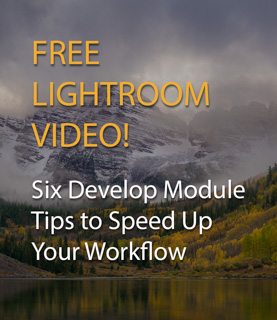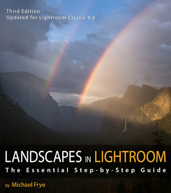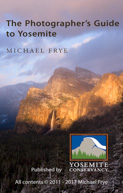In the Moment:
Michael Frye's Landscape Photography Blog
by Michael Frye | Nov 23, 2022 | Announcements
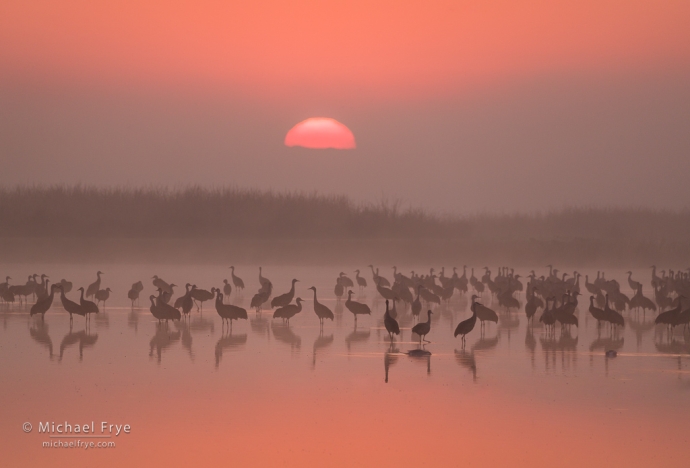
Misty sunrise with sandhill cranes, San Joaquin Valley, California
The Thanksgiving holiday is a good time to pause and think about all the things we have to be grateful for.
I’m very thankful for my family and friends. Our son recently got married to a wonderful woman, so I’m grateful that he’s settled and happy. I’m very lucky to have been married to the same kind and beautiful woman for over 35 years, and I hope our son’s marriage is as long and happy as ours.
And I’m always very grateful for the support I receive from you, my faithful blog readers. Your comments and emails help make writing this blog fun, and keep me motivated and inspired. Thank you!
Whether or not you celebrate Thanksgiving (or live in a country that celebrates it on a different day), I hope you all have a lot to be thankful for!
— Michael Frye
by Michael Frye | Nov 20, 2022 | Light and Weather, Vision and Creativity
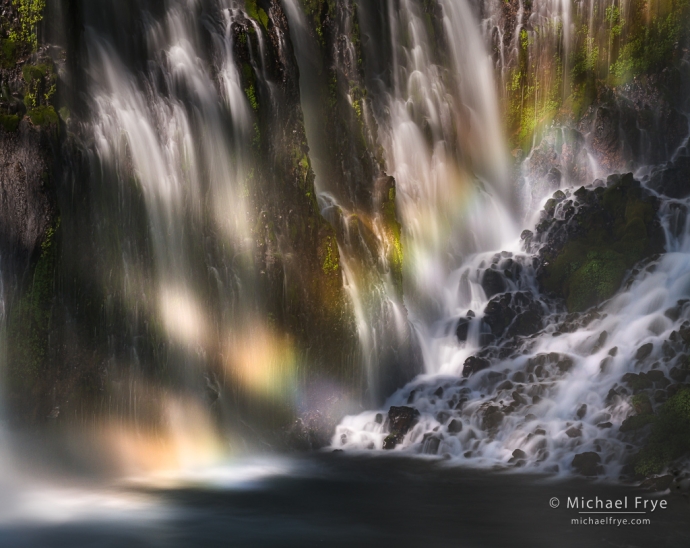
Tree shadows, rainbow, and waterfall, California. Claudia and I photographed this waterfall in soft light the evening before, but I came back the next morning hoping to see tree shadows when the sun got high enough. And sure enough, eventually trees cast beautiful striped shadows across the fall, creating a sunbeam-like effect. But I didn’t expect to also see a rainbow interspersed with the tree shadows – a nice bonus. I used a telephoto lens to fill the frame with the most eye-catching part of the scene, a polarizer to enhance the rainbow, and a neutral-density filter to slow down the shutter speed and give the water a soft, silky appearance. 135mm, 3 seconds at f/16, ISO 100, polarizer, ND filter (probably a 7-stop filter).
I love waterfalls. Who doesn’t? Besides their beauty, large waterfalls cast negative ions into the air, and negative ions supposedly have health benefits – making people feel refreshed and renewed, helping regulate sleep patterns and mood, reducing stress, and boosting the immune system. Or not; the scientific evidence is mixed at best. But whatever the reason, people seem magnetically drawn to waterfalls.
And of course waterfalls are quite photogenic. Over the past year I’ve had the opportunity to visit several waterfalls I’ve never photographed before. And while soft light usually works for waterfalls, I tried to seek out more unusual lighting conditions that could give the photographs a different look and feeling. That meant using sunlight, but waterfalls usually reside in basins and canyons, so they don’t often get that warm, low-angle light that we’re often looking for. And when the sun does get high enough to strike the fall, it’s often filtered through trees, creating splotchy light. Splotchy light can be harsh and downright awful, but sometimes, under the right circumstances, it can work. And – again, under the right circumstances – backlight can highlight a waterfall’s spray. And while front light is usually flat and boring, with waterfalls it can create rainbows.
(more…)
by Michael Frye | Nov 15, 2022 | Announcements
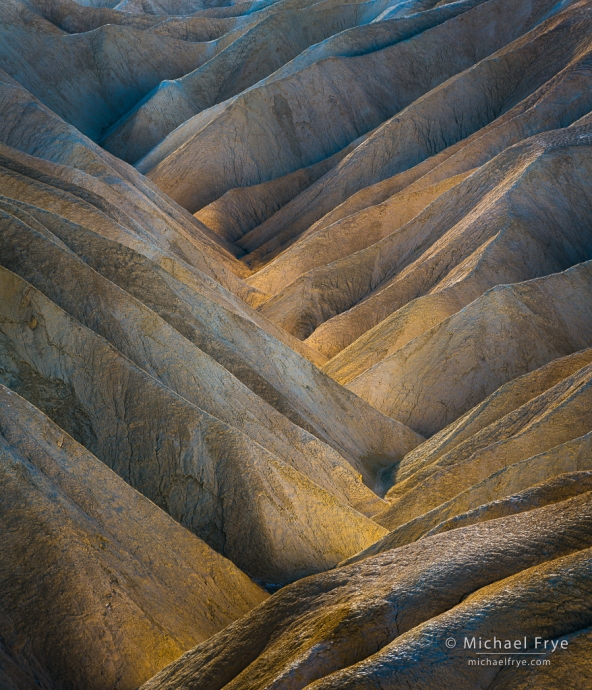
Luminous ravine, Death Valley
I’m honored to once again have one of my images included in the Natural Landscape Photography Awards. The image above from Death Valley won the third-place award in the Deserts category.
Congratulations to all the winners! You can see the competition galleries here. It’s a beautiful collection of photographs, and quite an honor to have my work included. As always, judging such things is highly subjective, and I’m sure there were many, many wonderful images submitted that didn’t get selected.
(more…)
by Michael Frye | Nov 13, 2022 | Travels and Stories
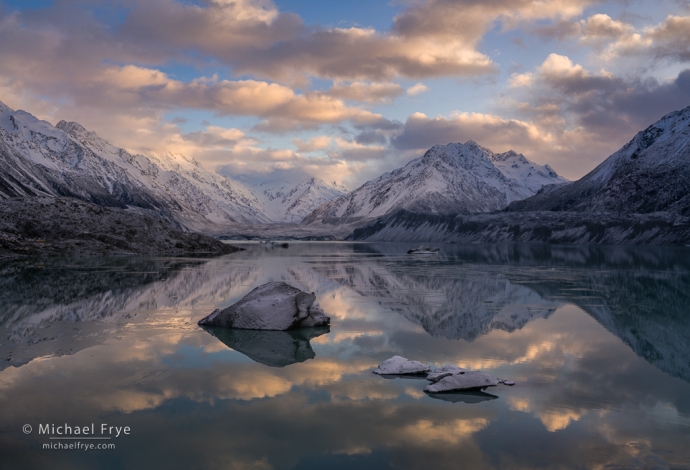
Sunrise at a glacial lake, New Zealand. It was a treat to photograph this glacial lake, complete with icebergs – something I don’t get to do in California! And with fresh snow to boot.
New Zealand’s South Island is remarkably diverse. It’s an area about the size of Colorado, yet contains temperate rain forests, dry grasslands, enormous natural lakes, and lots of beautiful coastline, including its renowned fiords.
And to top if off (literally), there’s also a range of high, snowy mountains – the Southern Alps. These mountains aren’t terribly high compared to some other ranges. The tallest peak, Aoraki / Mt. Cook, is “only” 12,218 feet (3,724 meters) above sea level. Compare that to Mt. Whitney, in my home mountains, the Sierra Nevada, at 14,505 feet (4,421 meters) – the tallest peak in the contiguous United States (the “lower 48”).
(more…)
by Michael Frye | Nov 5, 2022 | Announcements
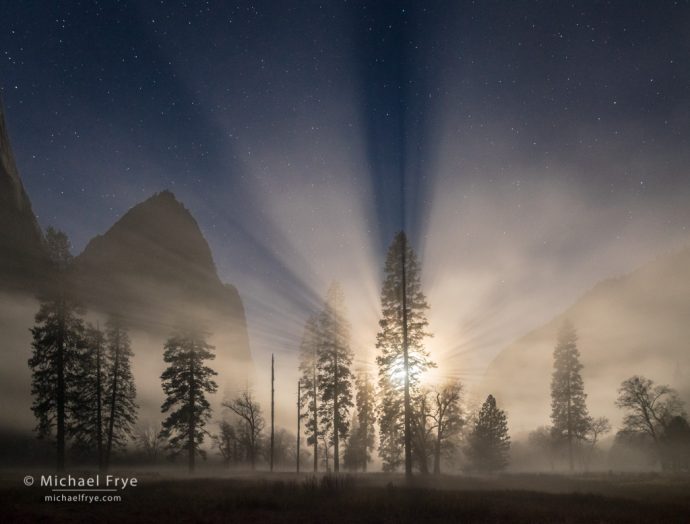
Moon setting on a misty night, El Capitan Meadow, Yosemite
I’m honored to once again have my photography included in Elements magazine, this time accompanying an in-depth interview. Elements is such a beautiful publication, and always full of thoughtful, interesting articles about landscape photography. This latest November issue includes photography and writing by Charlotte Gibb, Michael Bollino, Sarah Marino, Bruce Barnbaum, Joe Cornish, Alexey Korolyov, and Ed Cooley. I’m enjoying all the wonderful images, and looking forward to reading everything in depth.
You can subscribe to Elements here. I hope you enjoy this issue!
— Michael Frye
Related Posts: New Article in Elements Magazine; Elements Magazine Celebrates Printmaking
by Michael Frye | Nov 3, 2022 | Digital Darkroom
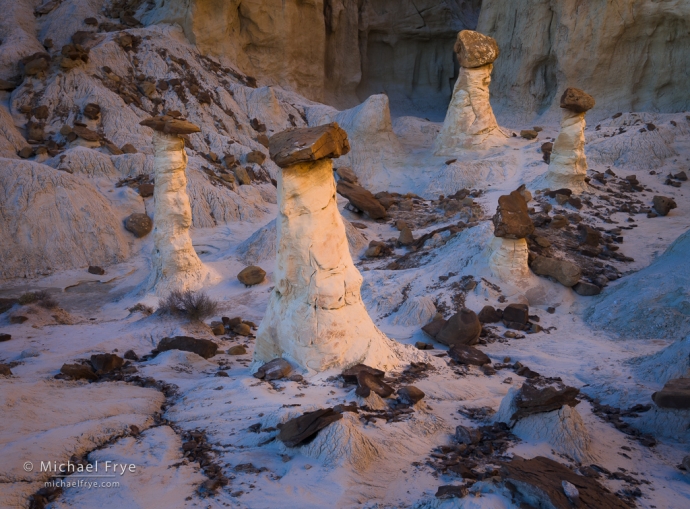
Hoodoos in reflected light, Grand Staircase-Escalante NM, Utah. The new Object selection tool helped me select just the hoodoos, then invert that selection and subtly darken their surroundings.
After coming back from New Zealand I spent a few days at home, then headed up to the Oregon Coast to scout for our upcoming workshop. It’s been a busy month, but before the workshop starts I want to share some thoughts about that latest Lightroom update.
On October 24th Adobe announced major updates to Lightroom, Lightroom Classic, and Adobe Camera Raw. (The new version of Lightroom Classic is 12.0.) And I think it’s a big upgrade. To me, the most exciting new features for landscape photographers are the addition of a Content-Aware mode for the Healing tool (formerly the Spot Removal tool), and the new Object Selection tool in the Masking Panel.
(more…)
by Michael Frye | Oct 19, 2022 | Travels and Stories
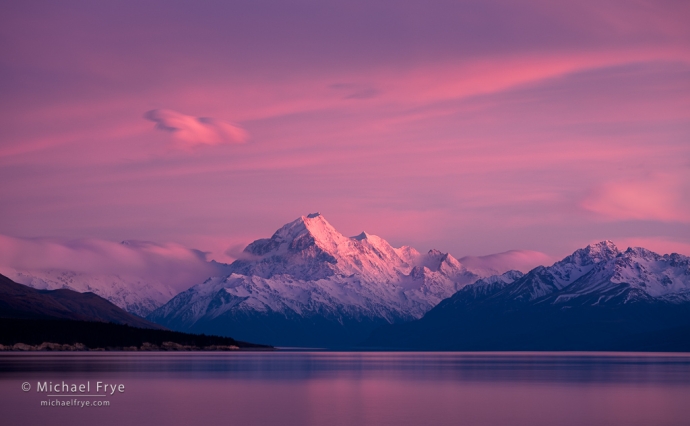
Aoraki/Mt. Cook at sunrise, New Zealand. This is the highest mountain in New Zealand. It’s covered in snow and ice year-round, but an antarctic cold front gave even the lower mountains a fresh coat of snow. I took this photo a good 40 minutes before sunrise as the predawn glow turned the mountains and clouds a vivid shade of pink.
I’m in the deep south. So far south that I’m down under – on New Zealand’s South Island.
Things can be disorienting here. I’m sure everything seems perfectly normal to New Zealanders, or to anyone who lives in the Southern Hemisphere, but to Northern Hemisphere residents like me everything is a bit upside down.
(more…)
by Michael Frye | Sep 22, 2022 | Light and Weather, Vision and Creativity
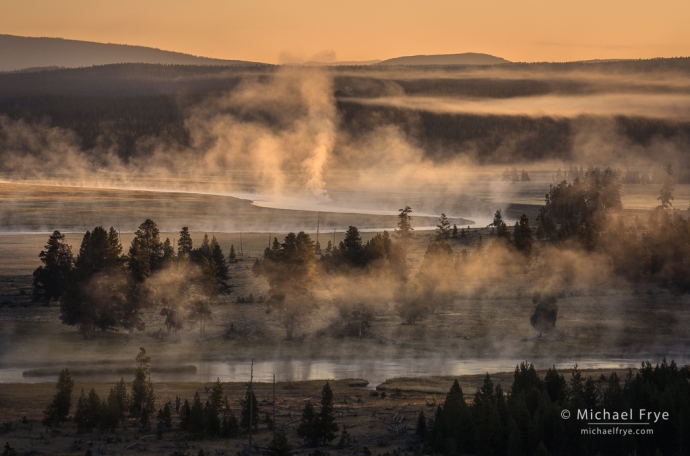
Layers of fog, Yellowstone NP, Wyoming. Early one morning I climbed a low hill, trying to gain some elevation so I could look down on the fog. After sunrise I noticed beautiful sidelight raking across this scene of a meandering river, so I raced along the hilltop to get a better view and composed this image. I like the horizontal layers of light and dark, punctuated by the vertical, curving column of steam that added a necessary visual focal point. 160mm, 1/20 sec. at f/16, ISO 100.
As I said in my last post, I love photographing fog and mist, so here are more misty images from our trip to Yellowstone. I explain my approach to photographing these scenes in that previous post, but the captions here contain more detail about the specific photos shown.
— Michael Frye
(more…)
by Michael Frye | Sep 20, 2022 | Light and Weather, Vision and Creativity
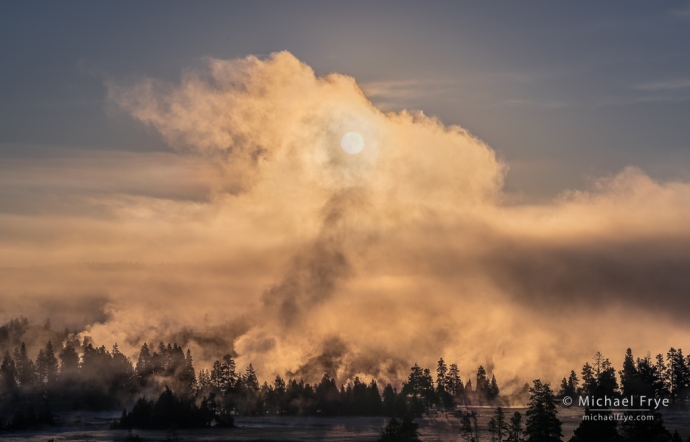
Sun rising through fog and steam, Yellowstone NP, Wyoming. Standing on a low hill, I moved to position the sun behind the column of steam, in order to avoid lens flare and prevent the sun itself from being completely blown out. With this extreme constrast I bracketed five frames, two stops apart, and blended the exposures with Lightroom’s HDR Merge. 100mm, bracketed shutter speeds, f/11, ISO 100.
If you read this blog regularly you know that I love fog and mist. And few places generate fog and mist as consistently as the thermal areas of Yellowstone during cold weather. Warm, moist air rising from the geysers and hot springs into the colder surrounding atmosphere creates a perfect recipe for mist formation.
During the first part of our stay in Yellowstone the daytime highs were in the low to mid 80s. But the daily temperature fluctuations were tremendous, so the next morning the thermal areas would be near freezing – a difference of around 50 degrees Fahrenheit (or about 28 degrees Celsius). So despite unusually warm days for early September, we still found plenty of steam and fog in the mornings. And toward the end of our stay a cold front came through, temps dropped, and we saw even more mist.
(more…)
by Michael Frye | Sep 7, 2022 | Night Photography, Travels and Stories
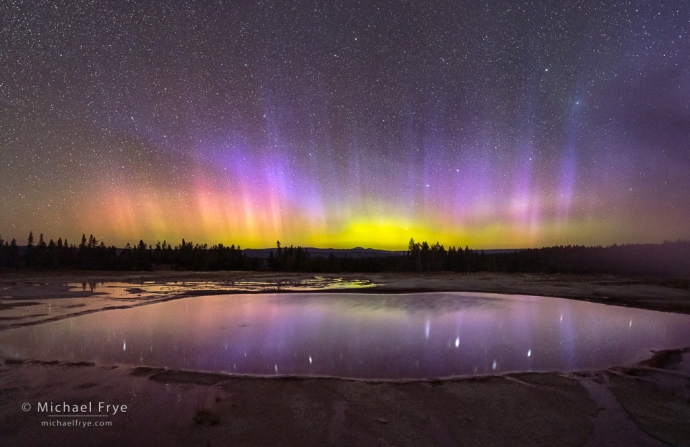
Aurora borealis reflected in a thermal pool, Yellowstone NP, Wyoming. 20mm, 10 seconds at f/1.8, ISO 6400. I would typically use a little longer shutter speed for night photos like this, but the aurora was moving and changing quite quickly, so a longer exposure would have caused the pillars to blur and smear together.
Claudia and I are back in Yellowstone. We had such a great time here last year we had to return.
And we’re glad we did. We’ve experienced many memorable moments so far, but the clear highlight was seeing and photographing the aurora borealis (aka Northern Lights) early Sunday morning.
We surely wouldn’t have done this if it weren’t for our friends David Kingham and Jennifer Renwick. Jennifer and David are both wonderful photographers, and know Yellowstone inside out. Before Claudia and I arrived in Yellowstone they saw and photographed an aurora one night. It wasn’t the most intense aurora, but it was something.
(more…)











